Audience personas aren’t real people, but they make a real difference in effective, consistent branding and messaging that earns real ROI. In this blog, Interact’s Vice President of Business Development Alana Villemez shares her top six tips for putting together stellar student personas backed by data to ensure you make every dollar count in your marketing, outreach, and retention efforts.
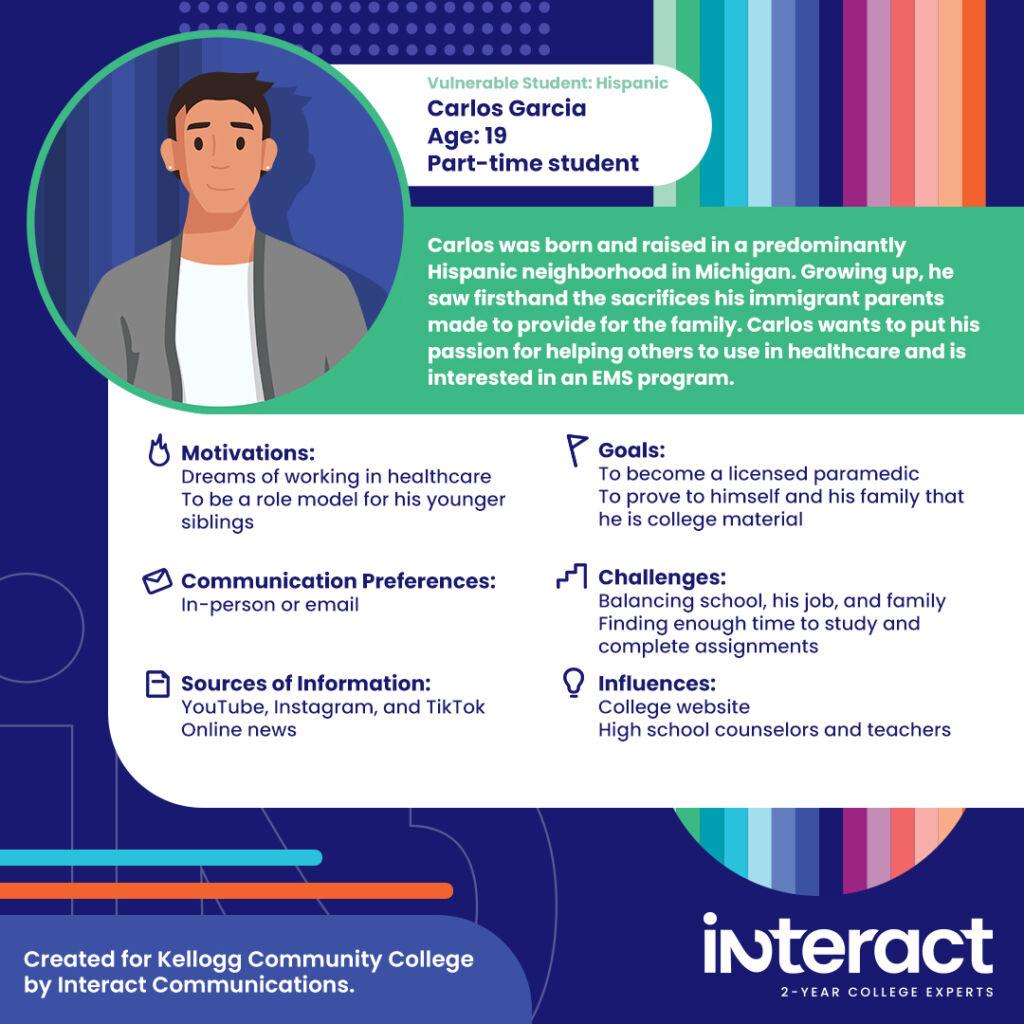
Example of a student persona from Kellogg Community College
But first, what are student or audience personas? And why do you need them?
Audience Personas Defined
“Audience personas” are composites that represent your audience segments, almost like fictional characters. Think of them like sketches. Personas give you just enough information to tailor your messaging and outreach to the right prospects.
Why Good Audience Personas Will Save You Money, Time, and Effort
It might seem silly to make up imaginary students to market to. But time and time again, we’ve seen personas make all the difference in marketing campaigns. With good personas in hand, suddenly, you are talking to the right kinds of students — the ones who are most likely to enroll and persist at your school. Not only that, but personas can help you shift to meet your target audience’s needs.
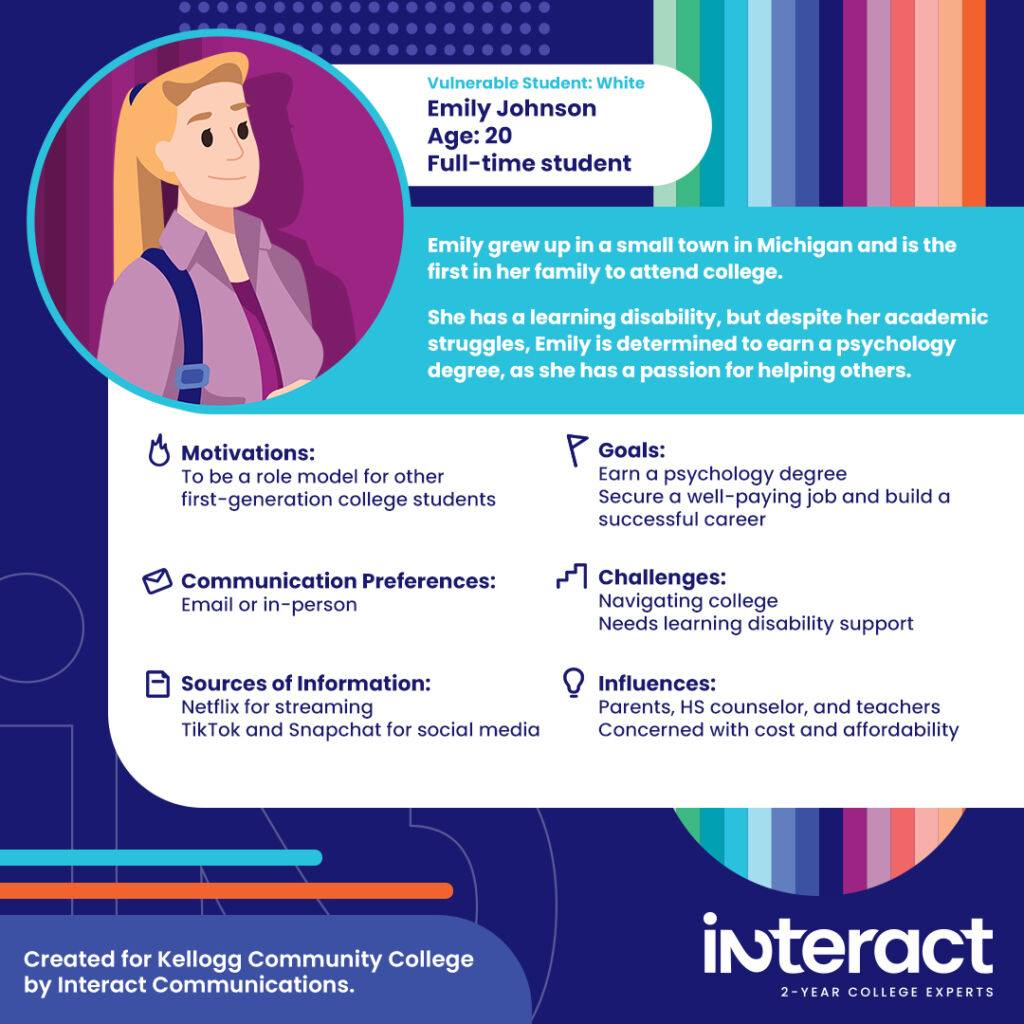
Example of a student persona from Kellogg Community College
Social media management platform Hootsuite says it best:
“Buyer personas remind you to put your audience’s wants and needs ahead of your own and help you create content to better target your ideal customer.
“You’ll give this buyer persona a name, demographic details, interests, and behavioral traits. You’ll understand their goals, pain points, and buying patterns. You can even give them a face using stock photography or illustration if you want — because maybe it’s important for your team to put a face to a name.”
— Hootsuite, How to Create a Buyer Persona
Just substitute “student personas” for “buyer personas,” and you’ll have the recipe for reaching more prospects. Building good personas is the foundation of any good marketing and outreach effort. Here’s why:
Why Good Audience Personas Matter
When you put faces onto your students, you’ll know how to appeal to their needs, aspirations, and pain points. You’ll also understand how to communicate with them over email, advertisements, and social media. Best of all? Student personas will help gain alignment and agreement across your departments to serve up consistent communications across the (literal) board.
“It’s always eye-opening for the board or president to see data-backed student personas,” says Villemez. “I’ve had a president say, ‘I guess what we thought is cool is not what students think is cool!’
“Student or audience personas really help you make headway internally and get your leadership on board.”
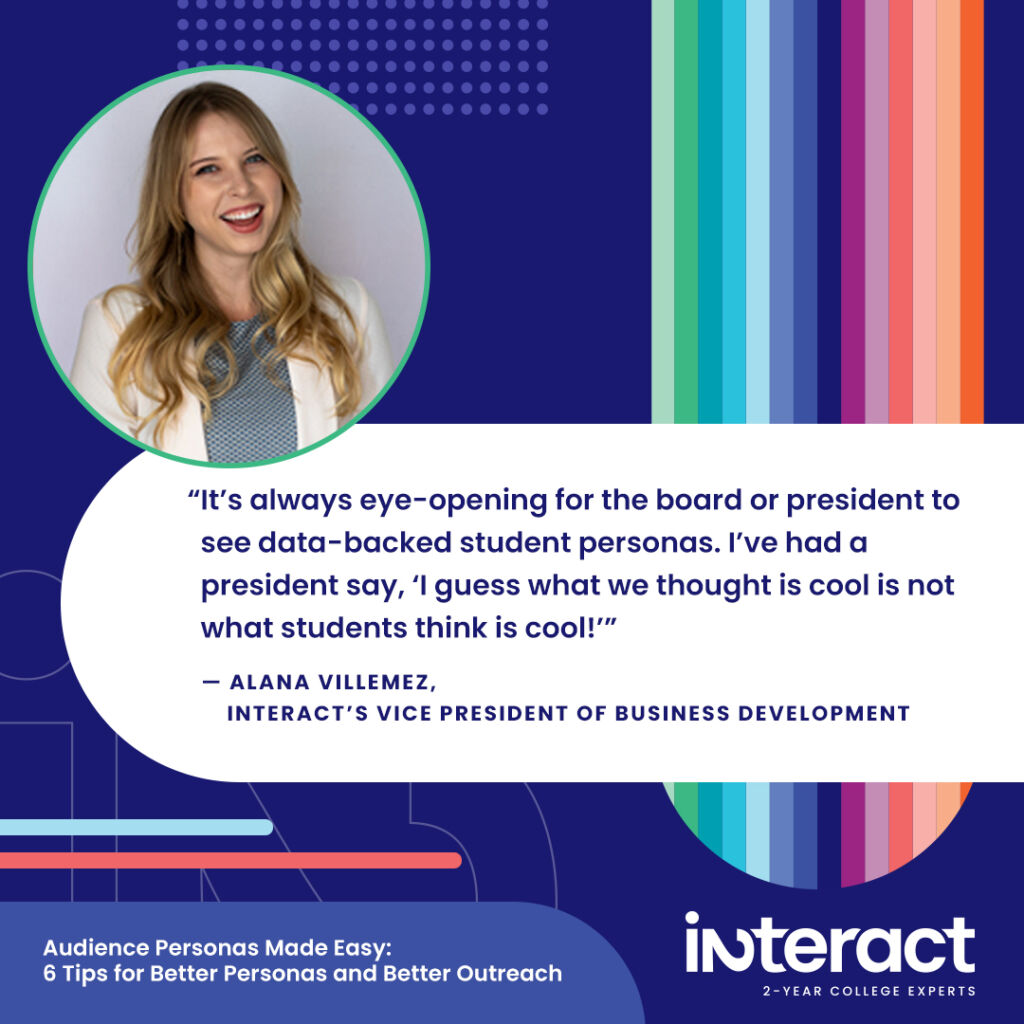
How to Make Spot-On Personas (With Helpful Examples!)
Now that you’re in the know about audience personas, here are Villemez’s top six tips for building robust ones:
1. Be Specific!
“Ultimately, in our targeting, we want to be really specific with our personas,” says Villemez.
As the old saying goes, market to everyone, and you market to no one. She says this is especially true about program marketing.
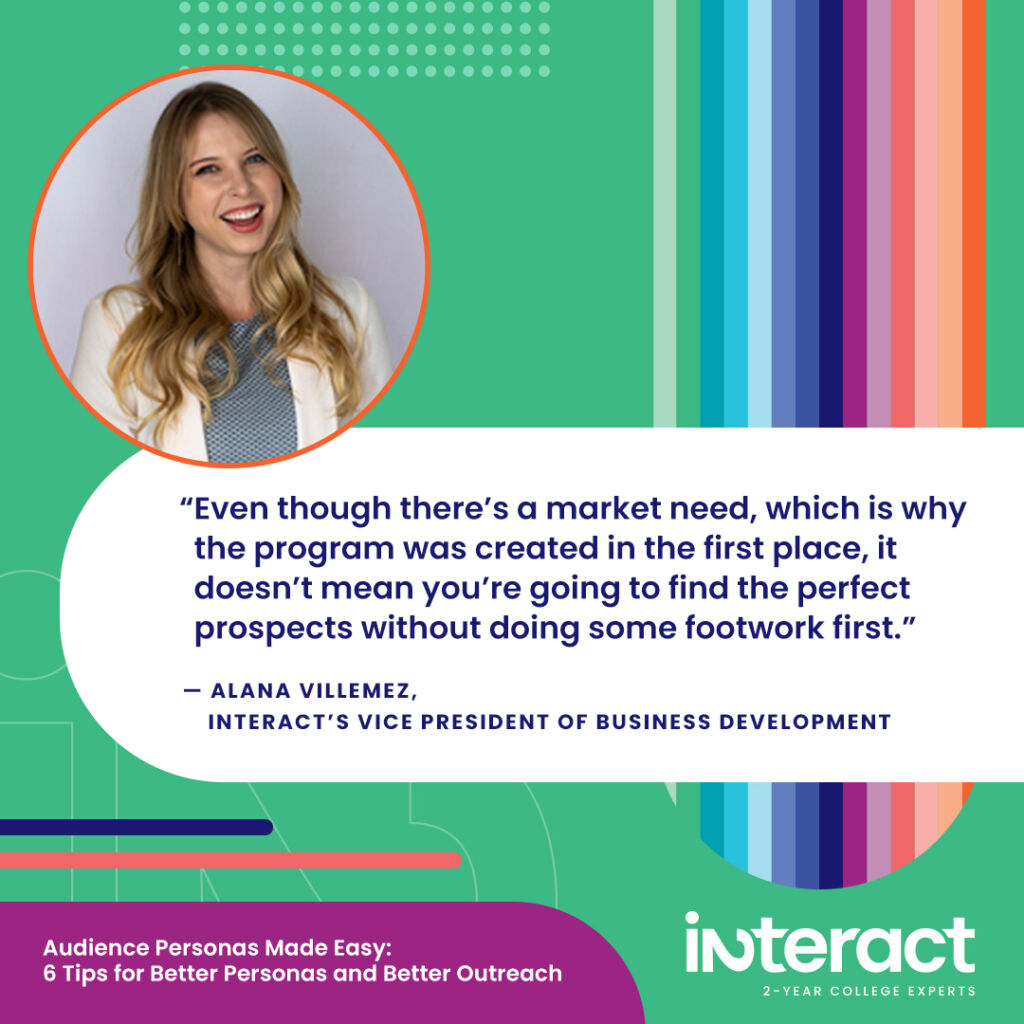
“If you have a dean asking you to market a new program, they may have no idea who in the community would be a good fit,” says our VP. “Even though there’s a market need, which is why the program was created in the first place, it doesn’t mean you’re going to find the perfect prospects without doing some footwork first.”
Making detailed personas helps ensure you’re not taking a shot in the dark at potential students.
To get the specificity you need to build the ultimate personas, you need research, research, research!
2. Derive Your Personas from Dependable Data
According to HubSpot, the best audience personas are all backed by robust data:
“The strongest buyer personas are based on market research and insights you gather from your actual customer base (through surveys, interviews, etc.).
“Your existing customer base is the perfect place to start your interviews … [but] don’t just talk to people who love your product and want to spend an hour gushing about you (as good as that feels). Customers who are unhappy with your product will show other patterns that will help you form a solid understanding of your personas.”
— HubSpot, How to Create Detailed Buyer Personas for Your Business
To make the best audience personas, you’ll want to ask your current students what they think. And whether they have positive or negative experiences to share, you’ll discover more about your college and your students’ goals, aspirations, and pain points.
a. How to Glean Good Persona Info
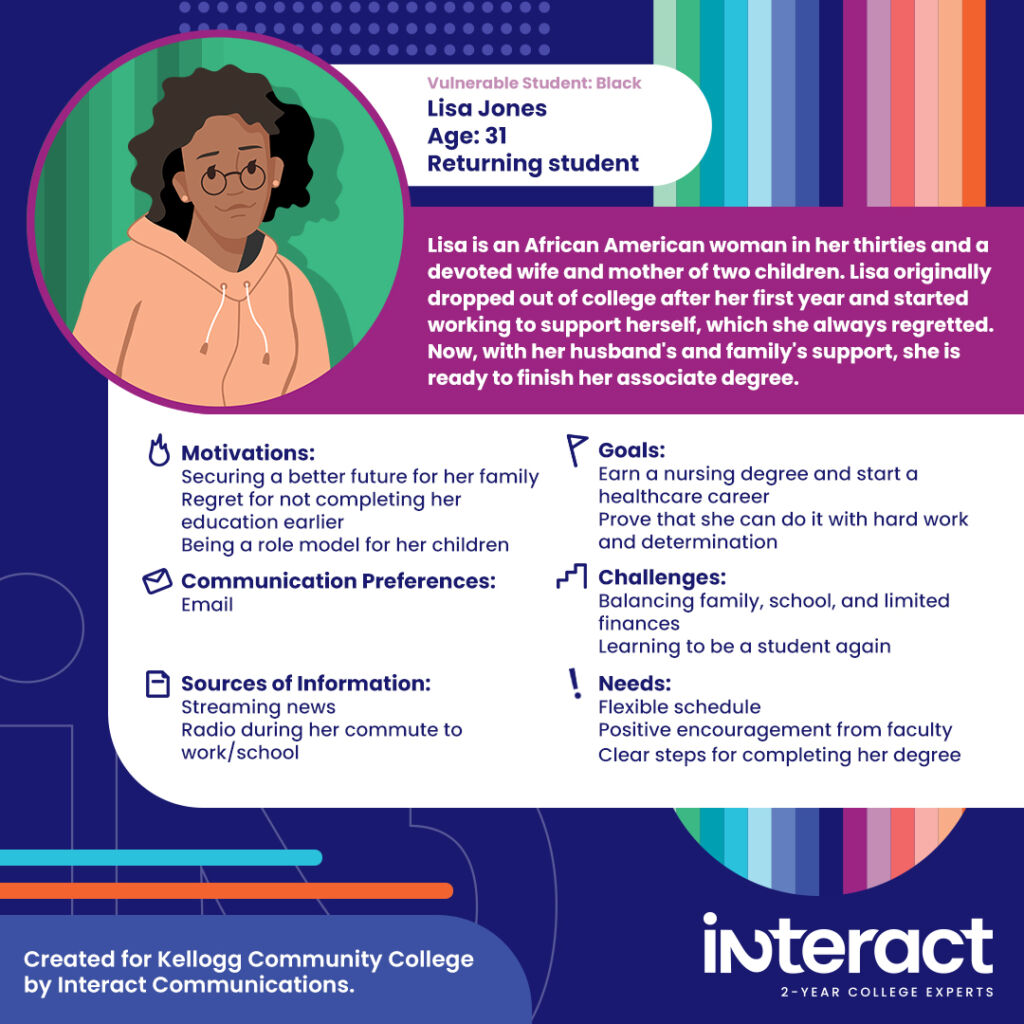
How can you determine your students’ likes and dislikes? Here are some good places to gather information:
- Request for information (RFI) forms that capture important persona data on your website
- Feedback from your student services teams about their interactions with learners
- Your social media analytics and Google Analytics
- And most importantly, through research, surveys, and interviews
Conducting research, surveys, and interviews is one of the best ways to gather persona information! The downside is that it can be costly to perform and difficult to organize and analyze your information. That’s why Interact created Media Prefs 17+ years ago to streamline, simplify, and turbo-charge student data for 2-year colleges.
Unlike giant advertising companies, which only give general demographic info, Media Prefs focuses 100% on community college student data, helping you obtain and analyze information right from your students! It’s a living data bank of community college student preferences and our partners’ secret weapon for making standout, data-driven, ROI-producing personas.
“We ask students directly about their perceptions of their specific college, so it’s very personalized to that community college’s student experience,” says Villemez. Bigger media conglomerates selling advertising data may also have ulterior motives: to convince you to buy over-the-top ads on their channels.
“Our Media Prefs data simply tells you exactly what your students’ goals, aspirations, and pain points are and where they spend the most time,” says Villemez. “That way, you can advertise directly to them with the right message on the right channels.”
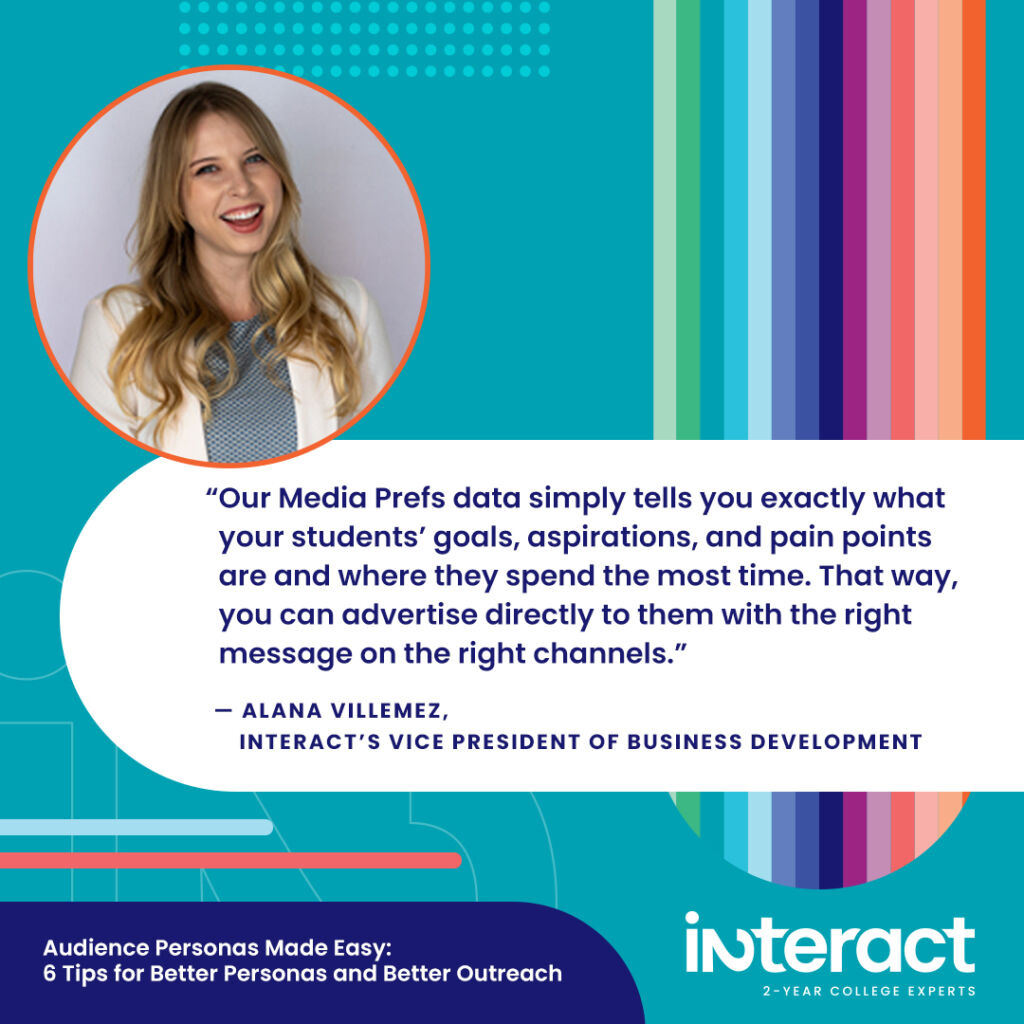
b. Example: How Washington State Used the Right Audience Personas to Drive ROI
The Washington State Board for Community and Technical Colleges (SBCTC) 34-college system had a statewide campaign to recruit adult learners. Specifically, they wanted students who made under a certain income and could benefit most from new grant assistance and financial aid services.
“We looked at their Media Prefs data to build personas, and because a majority of their 34 colleges had participated in the survey, we had a really robust amount of data,” says Villemez.
The team divided the student data by gender and age and then identified their favorite places to hang out online and what content they were consuming. From a strong foundation of student research, we conducted further surveys of students who received financial aid from the college system to gain insights into potential campaign messaging.
Student Preferences Steer Stronger Marketing
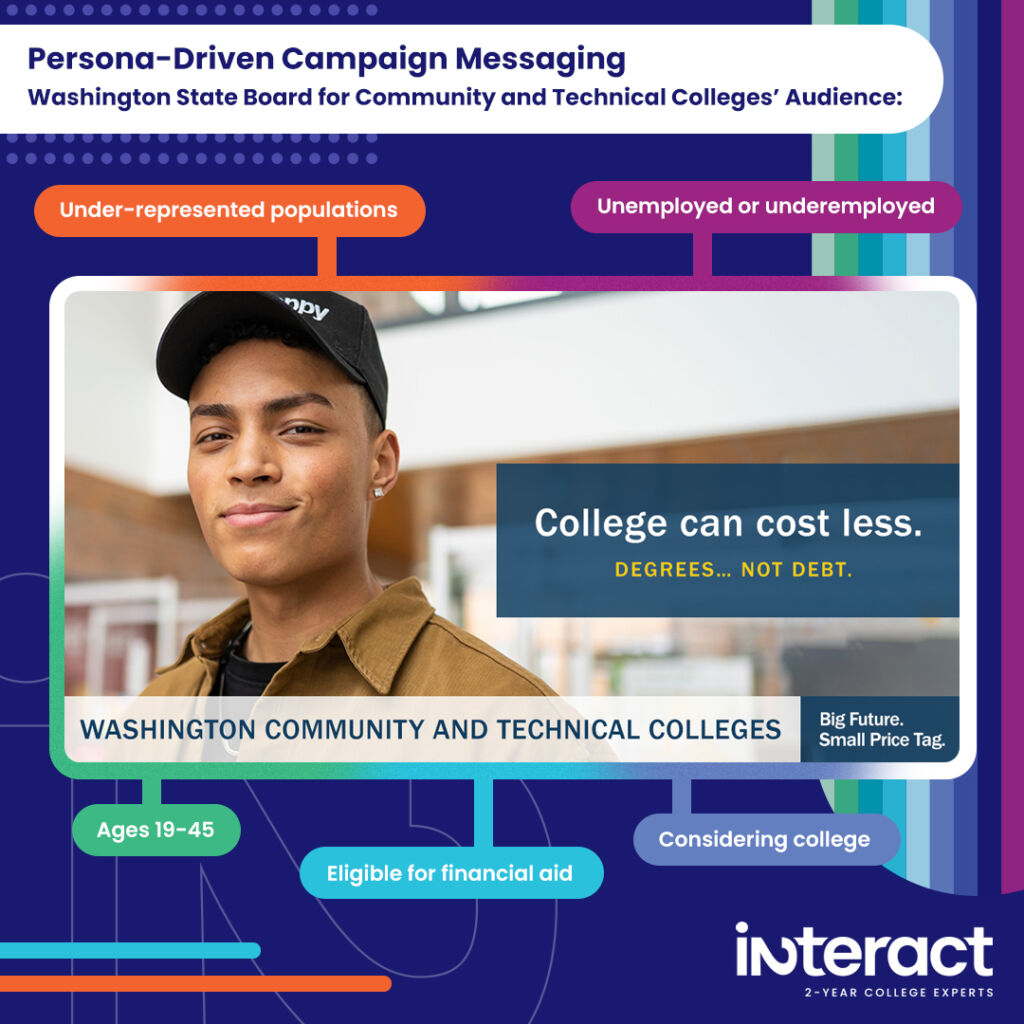
An example of how SBCTC’s persona attributes contributed to the targeted messaging arc
The team created five sample test messages from the data that were then retested by the students themselves. And instead of the messaging the presidents and the PIOs preferred? It was clear from the data that leadership’s least-favorite tagline was actually the students’ top choice!
Says Villemez, “We were all pleasantly surprised to go in the direction that students resonated with the most. Without the data, we never would have known the best course to take!”
On top of boosting branding, Media Prefs data also showed marketers the best channels to reach target personas. For example, the team dove into the data and found the most popular radio stations for students at each individual college. “Then, we drilled down and said, ‘Okay, these are the stations with the most crossover for all of our colleges, so this is where we should be spending the most money,’” recalls Villemez.
“We didn’t want to be spending funds where they didn’t need to be spent. Media Prefs was essential in making our marketing personas and outreach as targeted as possible.”
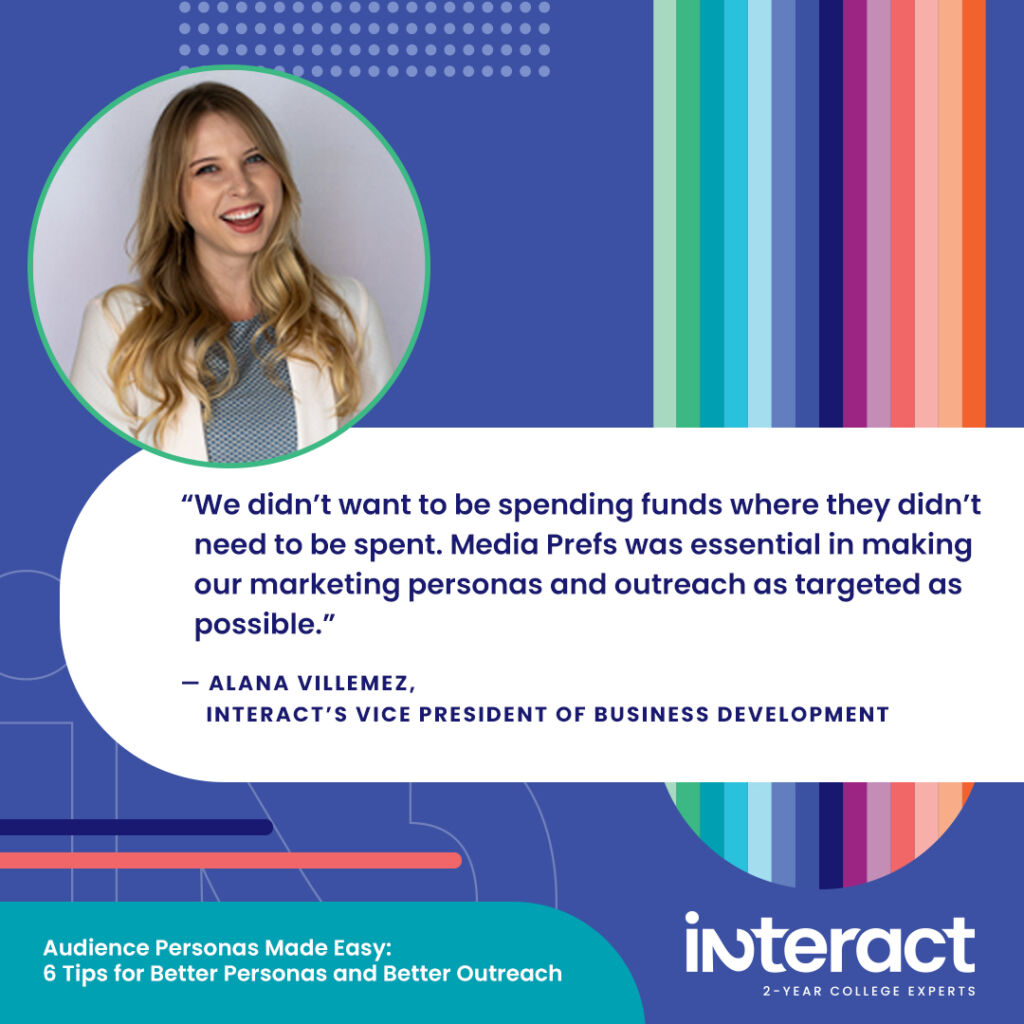
Audience Personas Drive Robust ROI
The hard work of building student personas paid off:
The campaigns have warranted over 35 million impressions. Most importantly, they amassed 215,432 website visits, with 163,167 attributed to digital campaigns — driving 76% of web traffic.
Not only were the web visits outstanding, but the conversions once visitors entered the site were even more impressive. The results of the specific targeting, even across the entire state of Washington, produced tremendous ROI:
- Program Clicks: 32,268 (14.9% CTR from web visits)
- Apply Clicks: 4,346 (2.0% CTR from web visits)
- Contact Us Clicks: 3,935 (1.8% CTR from web visits)
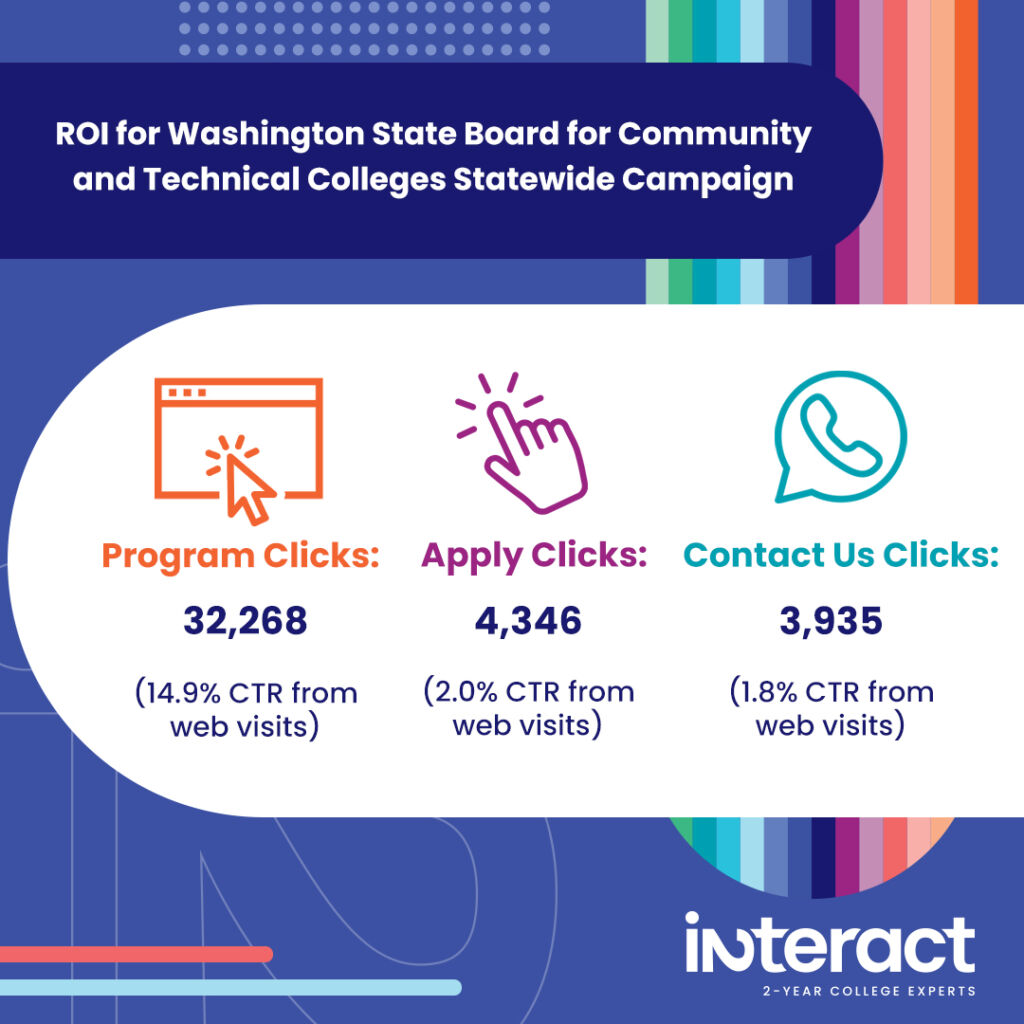
“It’s a great example of taking that Media Prefs data and getting clear about what students really want to focus your messaging,” says Villemez.
Read More: Group Effort with Gusto: First-Ever Statewide Campaign Builds “Big Futures”
4. Create Multiple Personas for All Your Audiences
One persona isn’t enough to represent your entire student body. You’ll need to scrutinize your data to find all your audience segments with unique goals, pain points, and preferences.
Online Learners in Orange County
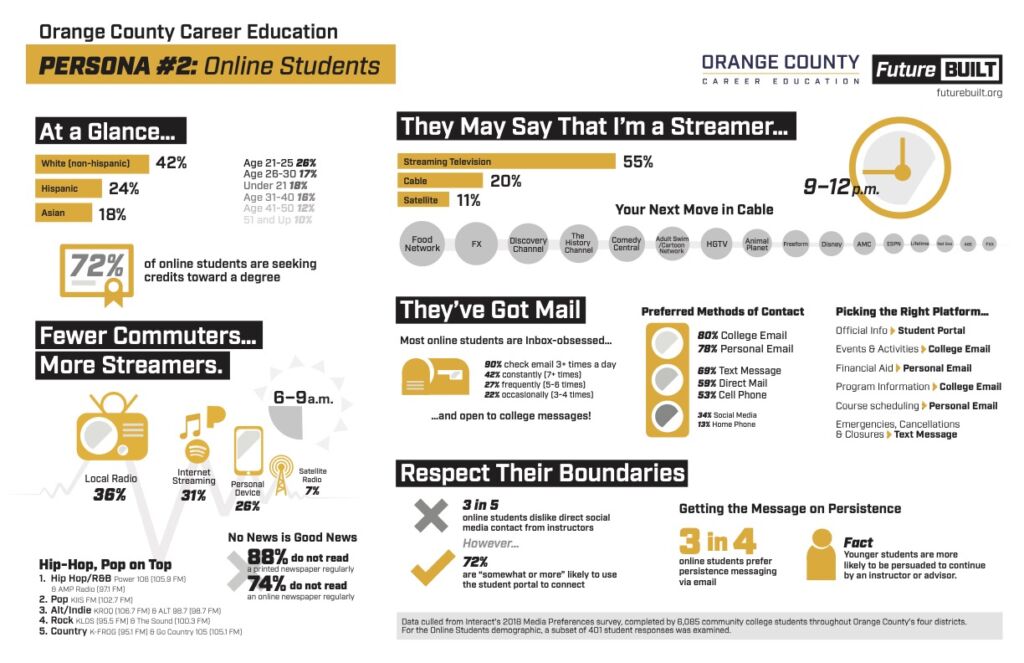
They may say I’m a streamer… OC example of online learner persona
Take the Orange County Regional Consortium, which wanted to produce custom, research-driven branding and messaging to bolster community awareness and interest. Creating detailed personas helped our partner target multiple audiences, including online learners. And though we created the online learner personas before the pandemic, in 2019? The research became essential for targeting this audience in 2020 and beyond. By analyzing student data from the Media Prefs survey and zeroing in on gender, age, and program, the partners realized the best place to reach future virtual learners was on the “tube.”
“We did a really heavy investment into YouTube, in addition to a couple of other channels,” recalls Villemez. “This program was going to be fully online, and prospects were already spending time online anyway on YouTube, which was great for us.”
Adult Learners Versus Traditional Students
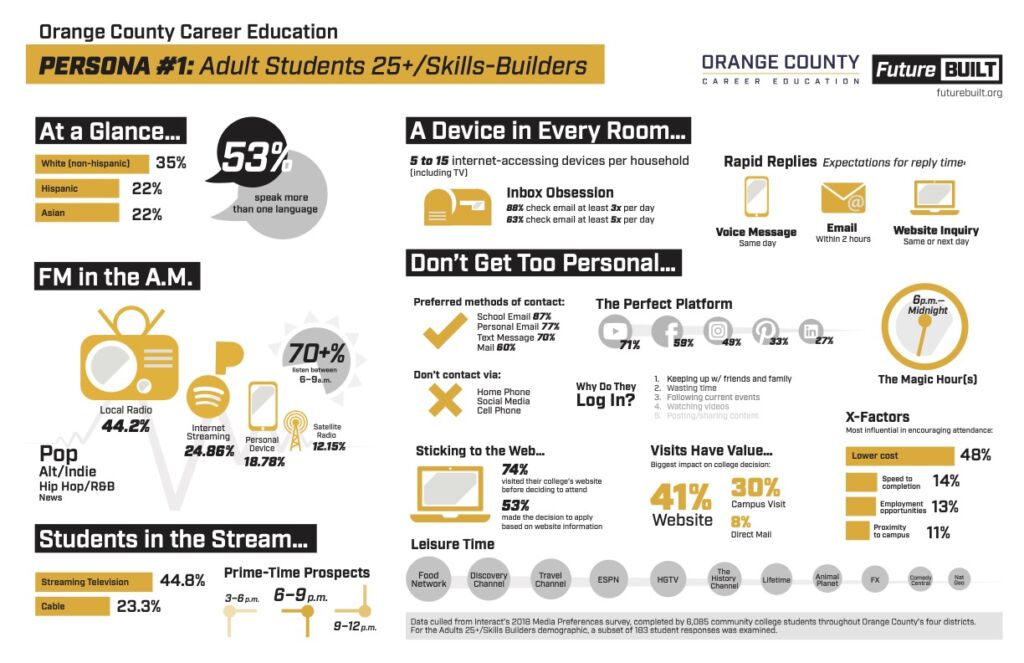
An example of an Orange County adult student persona
Persona research also helped the consortium reach adult learners and traditional students by understanding the differences between the two audiences.
“We usually know what traditional-age students are thinking, but adult learners are unique,” says Villemez. “The channels they spend their time on are different, and the messaging they resonate with varies, too.”
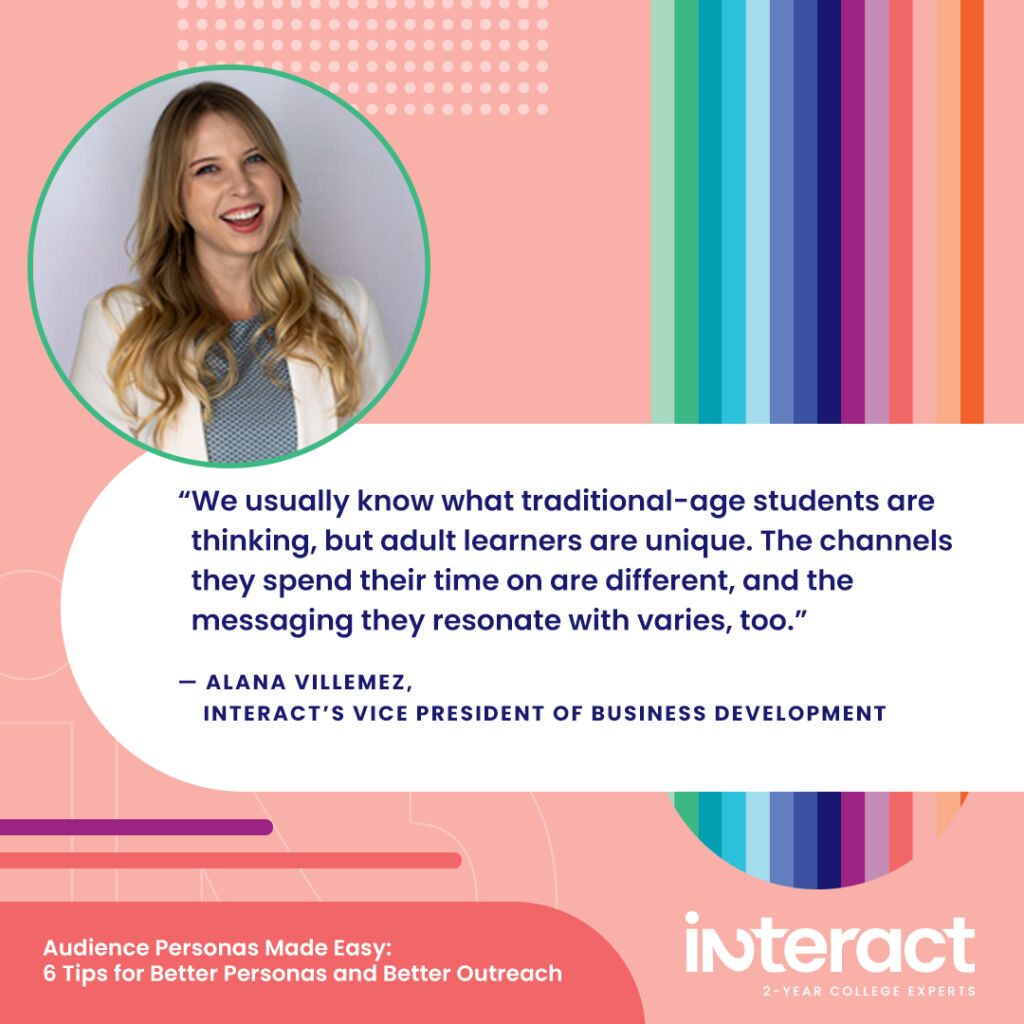
Adult learners even have a lot of variation within their demographic, including those looking for workforce development versus ESL, GED, or noncredit students. Each of these segments has their own unique preferences and needs and should have their own personas to represent them.
“We had to dive deep into Orange County’s Media Prefs data to hone their personas and craft their marketing strategy so they didn’t miss adult audiences,” shares Villemez. “When you look at adult learners’ survey responses, they are very different than traditional-age students.”
While traditional students might say they’re coming to their local community college because it is affordable and their friends are there? Adults might respond that they need child care help and more night classes.
“The narratives are entirely different, and we see that even in how they spend their time and what messaging they want,” says Villemez. “We often see colleges make just one evergreen ad set, and it’s all for traditional-age students. Our Media Prefs survey asks, ‘What do you want college recruiters to know?’ and a majority of students 25 and up will respond, ‘I want them to know I’m not straight out of high school.’”
To sum it up: Make sure you have a persona to represent every unique audience at your college.
5. Leveraging Qualitative Data to Address Persona Pain Points
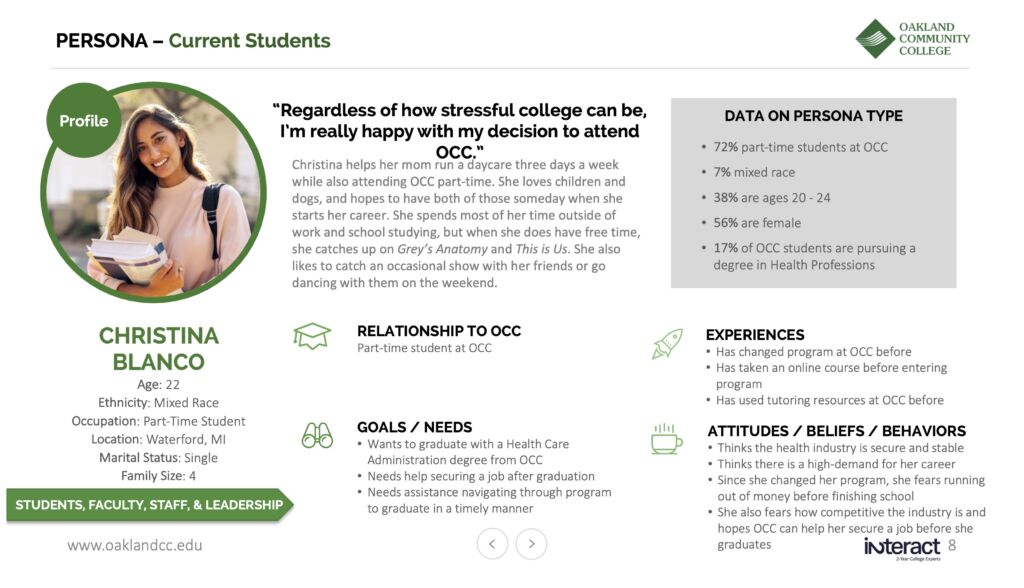
Student persona example from Oakland Community College
According to Hootsuite, using qualitative information can help your marketing persona come to life.
“Including some quotes (either repurposed from real customers or invented) can help give a character … a voice.
“You want your persona to seem like a real person. … Be sure to describe both who each persona is now and who they want to be. This allows you to start thinking about how your products and services can help them get to that place of ambition.”
— Hootsuite, How to Create a Buyer Persona
It’s easy to give your personas a voice using the qualitative data from Media Prefs. Here are just a few qualitative questions we ask in our survey:
- What is one thing college recruiters should know about the mindset of prospective students they talk with?
- Please share if there was a specific turning point or moment in your life that led to your decision to enroll in college.
- What was the biggest barrier you faced when applying to your college?
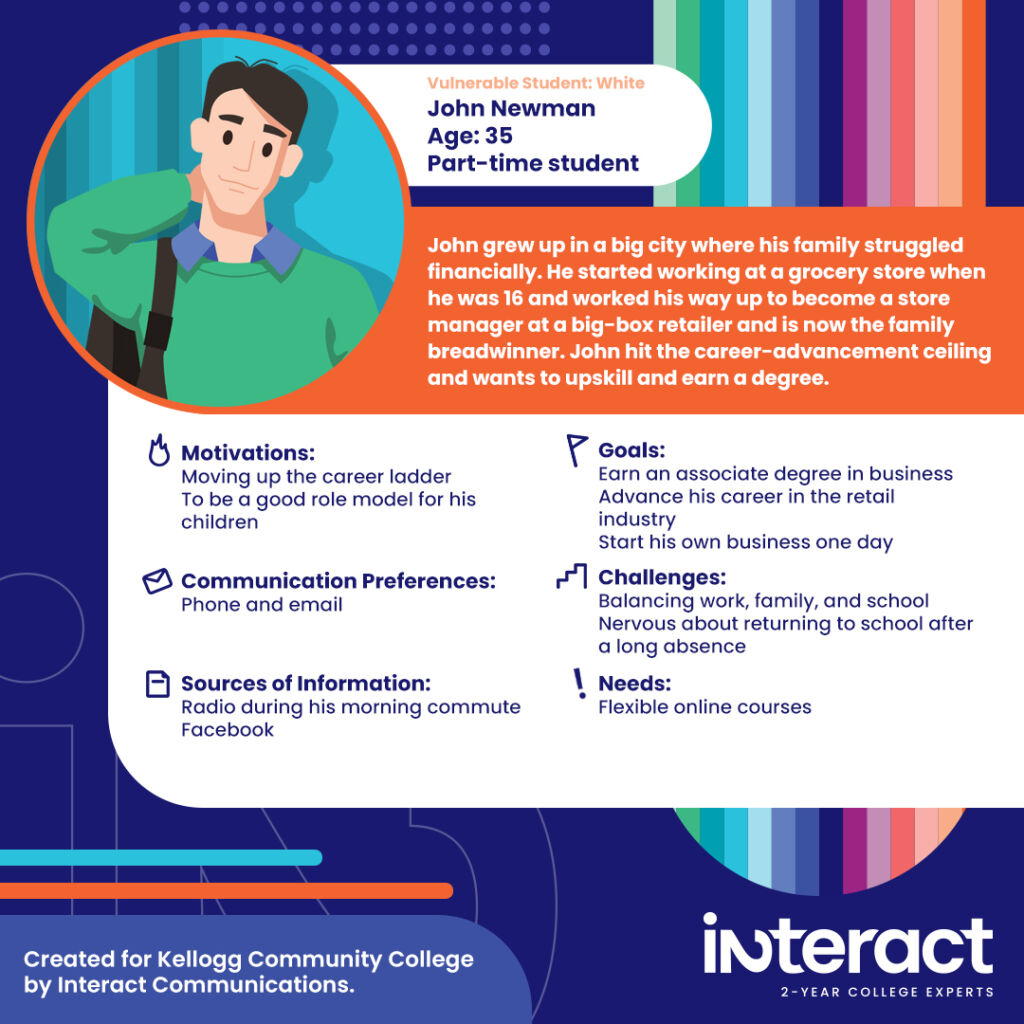
“That student feedback gives insight into your persona profiles and can also help you refine your messaging and cater your brand more effectively to these target audiences,” says Villemez.
“You can address their aspirations and goals. And you can even take their pain points and turn them into successes for your college, especially in your messaging and creative.”
6. Look at Your Full Funnel for Personas — Not Just the Top!
“The key to building personas is not only looking at the top of your funnel and making sure that resonates with students, but also finding out what students want in the middle of the funnel,” says Villemez.
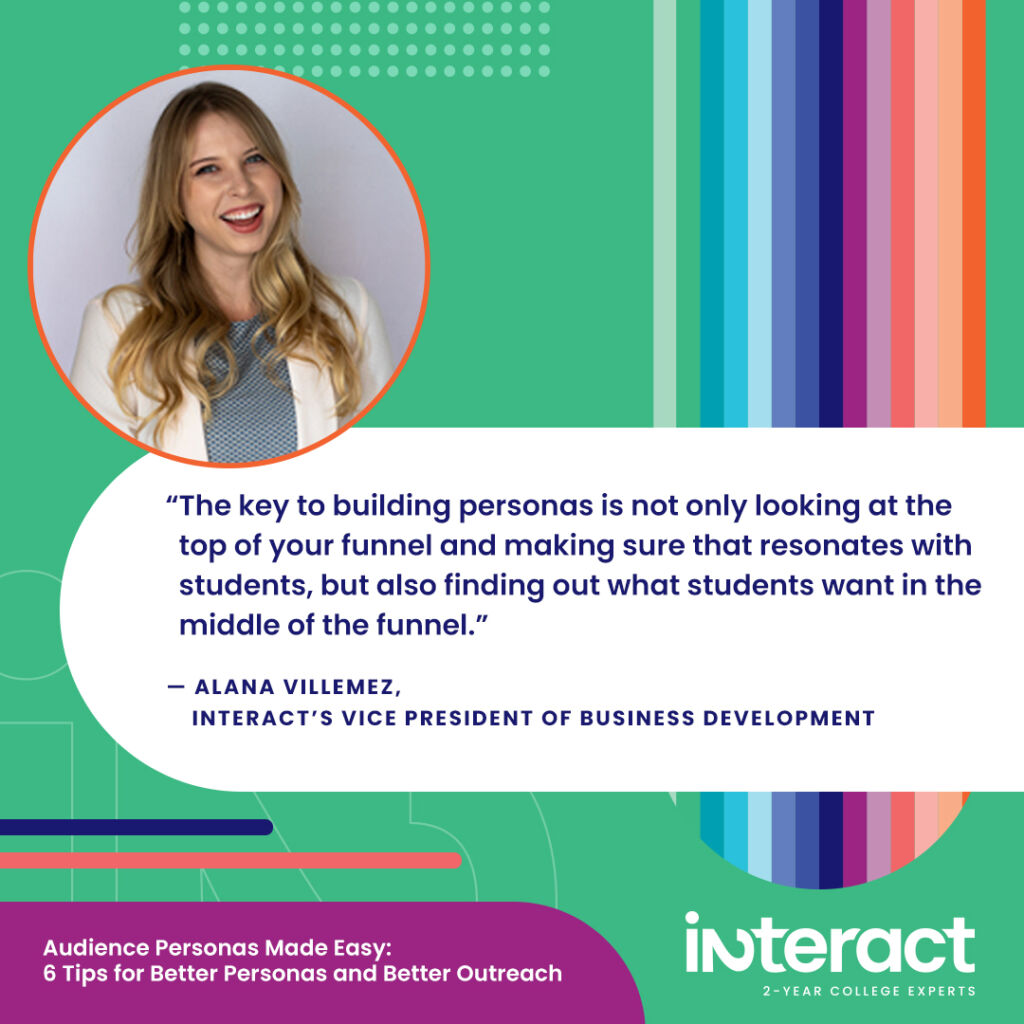
The middle of the funnel includes questions like, “What are students’ experiences with the college’s website?” and “What was a barrier to registering for classes?”
“So many people just look at the top of the funnel,” says Villemez. “Once learners get to the application, or send in an inquiry, or recruiters are talking to them, what are the messaging and the experience there?”
For many colleges, the biggest gap when building personas is including that middle-of-the-funnel experience. Thankfully, Media Prefs has plenty of middle-of-the-funnel survey questions for students, keeping your data, communications, and personas sharp!
Final Takeaways: Always Turn to Your Data When Building Your Audience Personas
The secret to stretching your marketing dollars further and reaching students is making strong personas based on real student data. It’s the only way to build personas that truly reflect your target audiences and move the needle on enrollment.
“It seems silly, and you might assume, for example, that everyone would like a text from the college — but it actually gets really complicated,” says Villemez. “The more you dive into your data, the more you realize that different groups of students have very different preferences.”
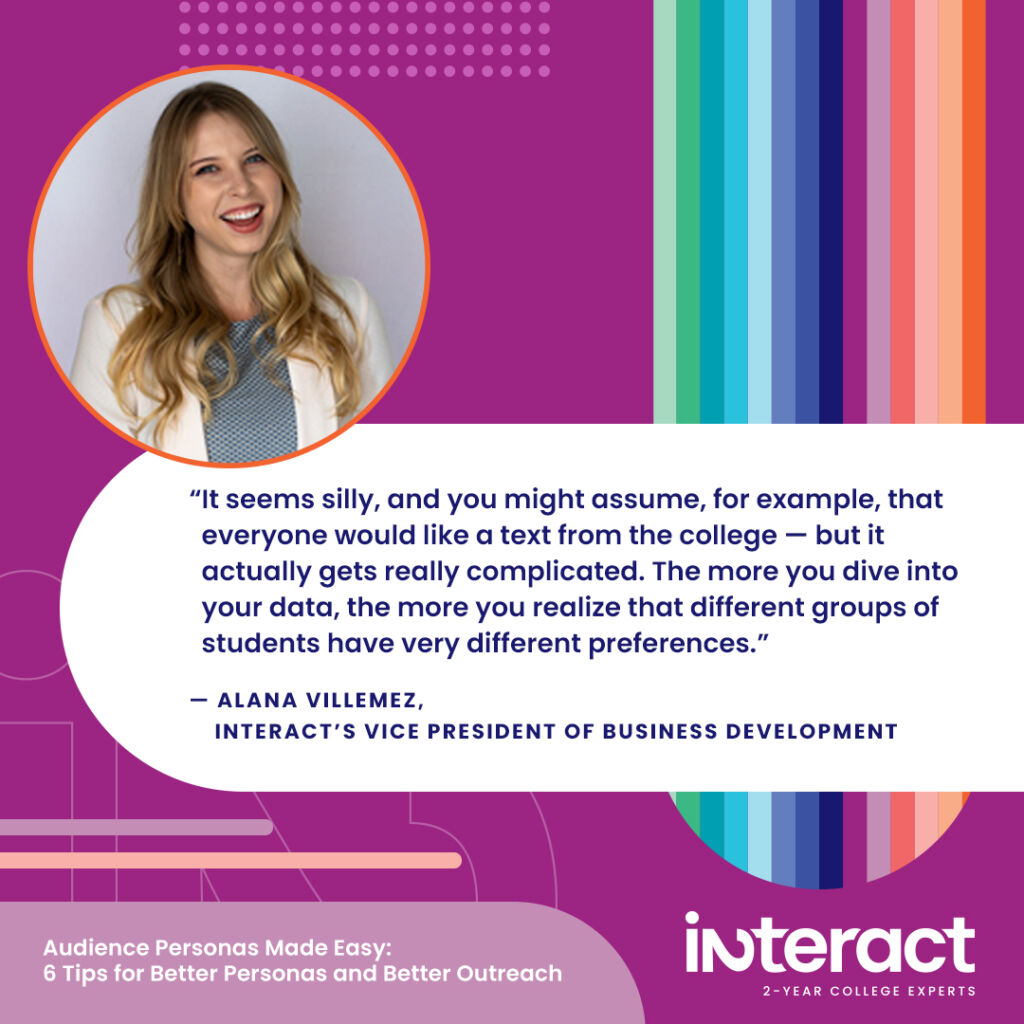
And if you need help building your student personas? It’s not too late to jump into the next Media Prefs survey period! Secure the data you need to reach the right students on the right channels with the right messaging.
Find out more about Media Prefs and save your spot at https://www.mediaprefs.com/the-inside-scoop.



